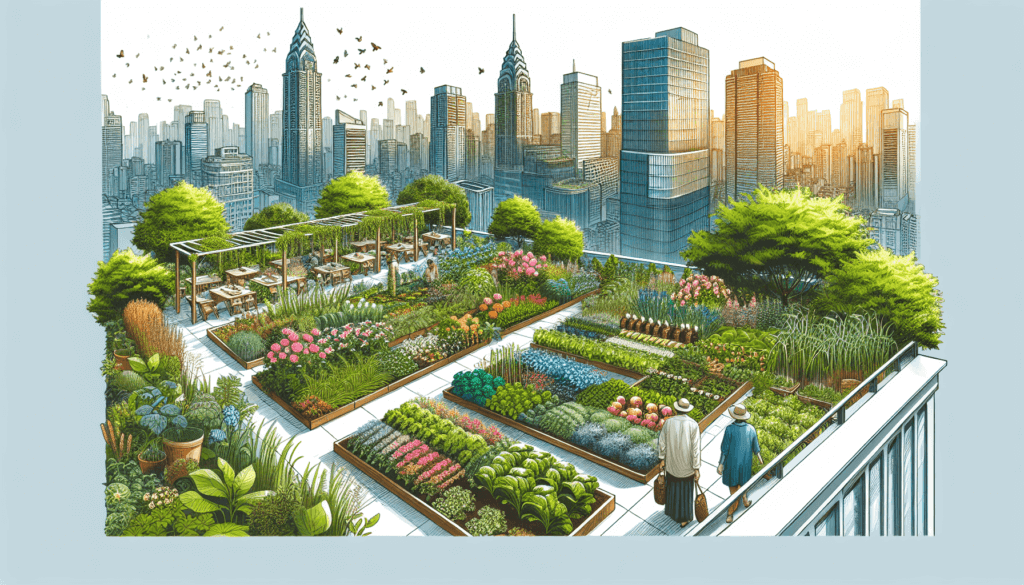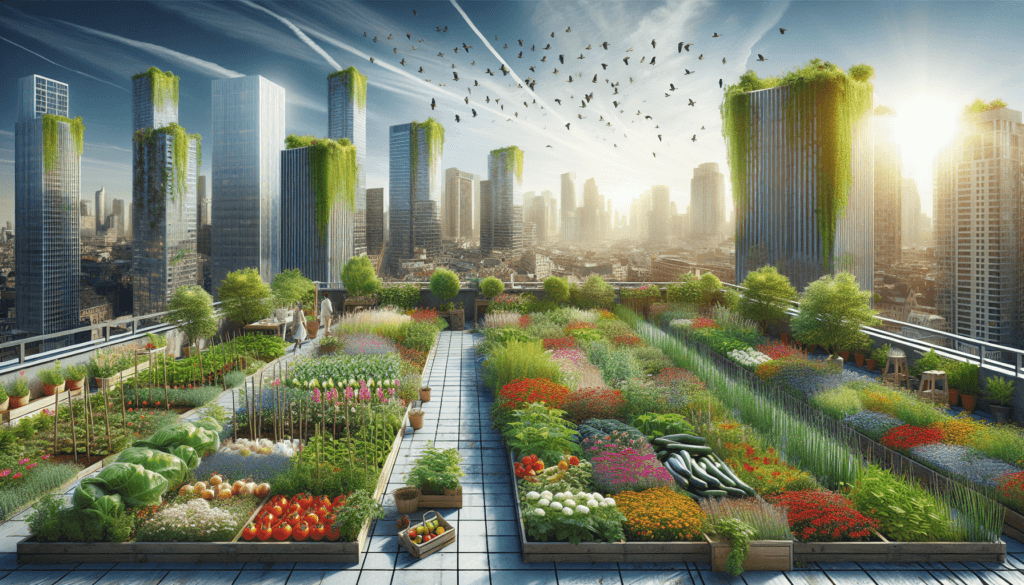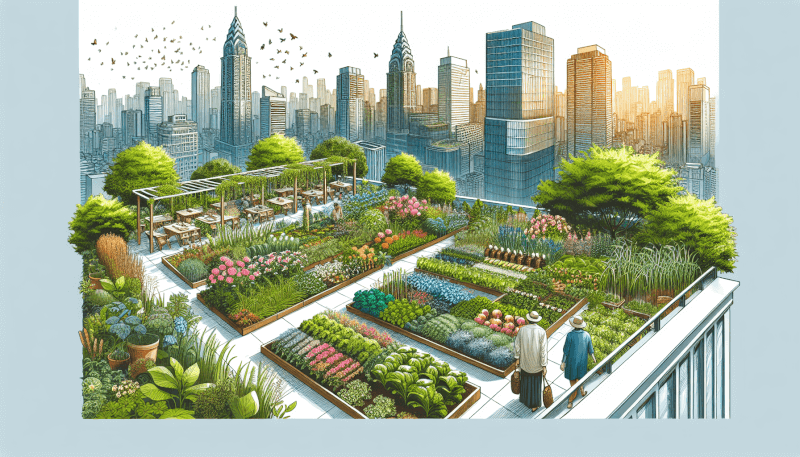Imagine having a lush and vibrant garden right on your rooftop, where you can escape the hustle and bustle of the city and connect with nature. Introducing the “Rooftop Garden Warmer,” a revolutionary device that combines functionality and aesthetics to create the perfect environment for your rooftop garden. With this innovative solution, you can now enjoy your green oasis all year round, regardless of the weather outside. Say goodbye to the limitations of traditional gardens and embrace the possibilities of a rooftop paradise.
Benefits of Rooftop Gardens
Improves air quality
Having a rooftop garden can greatly improve the air quality in your surroundings. Plants have the amazing ability to absorb carbon dioxide and release oxygen through the process of photosynthesis. By incorporating a garden on your rooftop, you are increasing the amount of oxygen in the air, making it fresher and healthier for everyone around. Additionally, plants also help in reducing air pollution by filtering out harmful pollutants and releasing clean air.
Reduces energy consumption
One of the significant benefits of rooftop gardens is their ability to reduce energy consumption. The additional layer of vegetation on your rooftop acts as a natural insulator, helping to keep your home cooler in the summer and warmer in the winter. This reduces the need for excessive heating or air conditioning, leading to lower energy bills and a more sustainable living environment. The plants also provide shade, reducing the heat island effect in urban areas.
Enhances biodiversity
Rooftop gardens provide a valuable habitat for various species of flora and fauna, contributing to the overall biodiversity of the area. The introduction of plants and trees on rooftops allows for the proliferation of insects, birds, and other small animals, creating a sustainable ecosystem in a typically urban and concrete-dominated environment. These gardens act as green corridors, connecting different green spaces and providing a safe haven for wildlife.
Factors to Consider for Rooftop Gardens
Structural integrity
Before creating a rooftop garden, it is crucial to assess the structural integrity of your building. Rooftop gardens can be heavy, especially when considering the weight of the soil, plants, and potential water accumulation during rainfall. Consult with a structural engineer to ensure that your building can support the additional load. Reinforcement may be required to prevent any structural damage.
Waterproofing
Waterproofing is a critical factor to consider when planning a rooftop garden. The presence of excessive moisture from watering the plants can cause leaks, leading to costly damages to the building’s structure. Ensure that proper waterproofing measures are in place, such as installing a reliable drainage system and sealing any potential entry points for water. This will protect both your rooftop garden and the building itself.
Weight capacity
As mentioned earlier, rooftop gardens can be quite heavy, so it is essential to determine the weight capacity of your rooftop. This will depend on factors such as the building’s construction materials, age, and design. Consult with a professional to calculate the maximum load your rooftop can withstand and ensure that your garden stays well within the safe weight limits.

Types of Rooftop Gardens
Intensive garden
An intensive rooftop garden is characterized by its use of a thicker layer of soil and a wide variety of plants, including trees, shrubs, and even vegetables. These gardens require regular maintenance, as they require more water and nutrients to support the diverse range of plants. Intensive gardens are ideal for rooftop spaces with strong structural support and a willingness to invest time and effort into their upkeep.
Extensive garden
Extensive rooftop gardens are designed with a thinner layer of soil and usually feature hardy, low-maintenance plants such as succulents, grasses, and wildflowers. These gardens require less water and maintenance compared to intensive gardens. Extensive gardens are suitable for rooftops with limited weight capacity and for individuals who prefer a more low-maintenance green space.
Semi-intensive garden
As the name suggests, semi-intensive rooftop gardens strike a balance between intensive and extensive gardens. They typically feature a moderate layer of soil and a mix of plant varieties that require varying levels of care. Semi-intensive gardens provide versatility in terms of plant selection and maintenance needs, making them a popular choice for those seeking a middle ground between intensive and extensive options.
Choosing Plants for Rooftop Gardens
Selecting native plants
When choosing plants for your rooftop garden, it is beneficial to select native species that are well-adapted to the local climate and environmental conditions. Native plants are more likely to thrive and require less maintenance, as they have evolved to withstand the specific challenges of the region. They also provide habitat and food for native wildlife, contributing to the overall biodiversity of your rooftop garden.
Considering sunlight exposure
The amount of sunlight your rooftop receives will play a significant role in the success of your garden. Observe the different areas of your rooftop throughout the day to determine the amount of sunlight each receives. Some plants require full sun, while others thrive in partial shade. By considering sunlight exposure, you can select the appropriate plants that will flourish in your specific rooftop garden conditions.
Ensuring proper drainage
Proper drainage is crucial for the health of your rooftop garden. Excessive water accumulation can lead to root rot and other plant diseases. It is essential to have a well-designed drainage system in place to prevent waterlogging and to redirect excess water away from the rooftop. This can be achieved through the use of drainage layers, permeable materials, and strategic planting to encourage natural water flow.

Designing a Rooftop Garden
Planning the layout
Begin designing your rooftop garden by planning the layout. Consider the available space, the weight capacity of your rooftop, and the desired functions of your garden. Determine the areas for seating, pathways, and plant beds. Maximizing space efficiency is key, especially in smaller rooftop gardens. A well-planned layout ensures that your garden is aesthetically pleasing and functional.
Creating vertical gardens
Vertical gardens are an excellent way to make the most of limited space in a rooftop garden. They involve growing plants vertically on walls or structures, utilizing the vertical plane to increase planting area. Vertical gardens can be created using various methods, such as attaching modular containers or trellises for climbing plants. These gardens not only add visual interest but also provide additional insulation and privacy.
Incorporating seating areas
Make your rooftop garden a comfortable and inviting space by incorporating seating areas. Whether it is a cozy corner with a small bench or a larger lounge area with loungers and hammocks, providing seating allows you to fully enjoy your rooftop oasis. Consider the views from different seating locations and create areas that offer shade, privacy, and a pleasant atmosphere to relax and unwind.
Irrigation and Watering Systems
Drip irrigation system
A drip irrigation system is considered one of the most efficient ways to water rooftop gardens. It delivers water directly to the roots of plants, minimizing evaporation and water waste. Drip irrigation systems can be automated and adjusted to deliver the appropriate amount of water based on the specific needs of different plants. They also help prevent overwatering, reducing the risk of root diseases.
Rainwater harvesting
Rainwater harvesting is a sustainable and cost-effective method of watering your rooftop garden. By collecting rainwater in storage tanks or barrels, you can utilize it for irrigation instead of relying solely on municipal water sources. Implementing a rainwater harvesting system allows you to reduce your environmental impact and conserve water while ensuring your plants receive a consistent supply of water.
Automated watering systems
For those who prefer a hands-off approach to watering, automated watering systems can be employed in rooftop gardens. These systems can be programmed to water plants at specific times and intervals, ensuring optimal moisture levels without requiring daily manual watering. Automated systems may use sprinklers, misters, or drip irrigation to deliver water efficiently to your plants, even when you are away from home.
Maintenance and Care for Rooftop Gardens
Regular watering and fertilizing
Regular watering is essential to keep your rooftop garden healthy and vibrant. Monitor the moisture levels in the soil and adjust your watering schedule accordingly. Additionally, fertilizing your plants periodically will provide them with essential nutrients for growth. Choose organic fertilizers to promote a healthy ecosystem in your rooftop garden, ensuring the well-being of both plants and the wildlife they attract.
Weed control
Weeds can quickly invade a rooftop garden, competing for nutrients and space with desired plant species. Regular weeding is necessary to keep your garden free of weeds and maintain the health of your plants. Use organic mulch or weed barriers to help suppress weed growth, minimizing the time and effort spent on weed control.
Pruning and trimming
To ensure the proper growth and appearance of your rooftop garden plants, regular pruning and trimming are essential. Remove any dead or diseased branches, shape plants as needed, and promote healthy growth. Proper pruning techniques will help maintain the overall structure and aesthetic appeal of your garden while reducing the risk of pest and disease infestations.
Common Challenges and Solutions
Wind exposure and plant protection
Rooftop gardens are often exposed to strong winds, which can damage plants and hinder their growth. To protect your plants from excessive wind exposure, consider installing windbreaks such as trellises, nets, or screens. These will help create a more sheltered environment for your rooftop garden and prevent wind damage. Choose wind-resistant plant species and secure them with stakes or plant ties if needed.
Pest control
Pests can be a challenge in any garden, including rooftop gardens. Common pests such as aphids, snails, and slugs can affect the health of your plants. Implement pest control measures such as regularly inspecting plants for signs of infestation, using organic pest repellents, and introducing beneficial insects like ladybugs or praying mantises. Regularly clean and remove any debris that may harbor pests.
Managing excessive heat
Rooftop gardens can be subjected to intense heat, especially during summer months. Choose heat-tolerant plant varieties that can withstand higher temperatures. Provide shade for sensitive plants with structures like pergolas or shade cloth. Use light-colored or reflective materials for your rooftop surface, reducing heat absorption. Regularly monitor soil moisture levels to prevent dehydration in hot weather.
Rooftop Garden Accessories
Garden furniture
Adding garden furniture to your rooftop garden enhances its usability and creates a comfortable outdoor living space. Consider options such as lounge chairs, tables, benches, or even hammocks to relax and enjoy your garden oasis. Choose furniture made from weather-resistant materials to ensure durability and longevity in outdoor conditions.
Outdoor lighting
Installing outdoor lighting in your rooftop garden allows you to enjoy the space even after the sun sets. Consider different lighting options such as string lights, lanterns, or wall-mounted fixtures to create a cozy and inviting atmosphere. Ensure that the lighting is appropriately positioned to highlight specific features of your garden and provide adequate illumination for safety and visibility.
Plant containers
Choosing the right plant containers is crucial for the success of your rooftop garden. Opt for lightweight containers made from materials such as fiberglass, plastic, or resin to minimize the weight load on your rooftop. Ensure that the containers have proper drainage holes and are of adequate size for the mature growth of your chosen plants. Additionally, consider the aesthetic appeal of the containers, as they can add a decorative element to your rooftop garden.
Inspiring Rooftop Garden Examples
The High Line, New York
The High Line in New York City is a remarkable example of a rooftop garden transformed into a public park. Built on an old elevated railway, this linear park features a stunning assortment of native plants, trees, and grasses. The High Line offers visitors a unique walking experience amidst an urban oasis, with panoramic views of the city skyline. It demonstrates how a rooftop garden can be transformed into a vibrant and sustainable public space.
Gardens by the Bay, Singapore
Gardens by the Bay in Singapore is a world-renowned attraction that showcases the fusion of nature and modern technology. It features stunning rooftop gardens, known as the Supertree Grove, with towering artificial trees that provide shade and host a variety of plants. The rooftop gardens at Gardens by the Bay boast impressive vertical gardens and offer visitors breathtaking views of the city and the iconic Marina Bay Sands.
The Roof Gardens, London
The Roof Gardens in London is a hidden gem nestled on top of a building in Kensington. This unique rooftop garden spans over 1.5 acres and is divided into themed areas, including Spanish, Tudor, and English Woodland gardens. The Roof Gardens offer visitors a tranquil escape from the bustling city, showcasing the beauty of nature in an unexpected setting. It serves as an inspiration for rooftop gardens that prioritize aesthetics and provide a peaceful retreat in an urban environment.
In conclusion, rooftop gardens offer numerous benefits, including improved air quality, reduced energy consumption, and enhanced biodiversity. When planning a rooftop garden, it is crucial to consider factors such as structural integrity, waterproofing, and weight capacity. There are different types of rooftop gardens to suit various preferences and space constraints. By choosing suitable plants, designing an efficient layout, and implementing proper irrigation systems, rooftop gardens can thrive. Regular maintenance and addressing common challenges such as wind exposure, pest control, and excessive heat are essential for the long-term success of rooftop gardens. Additionally, incorporating accessories such as garden furniture, lighting, and plant containers adds functionality and aesthetics. Inspired by notable rooftop garden examples like The High Line, Gardens by the Bay, and The Roof Gardens, individuals can embrace the beauty and sustainability of rooftop gardens in their own spaces.


